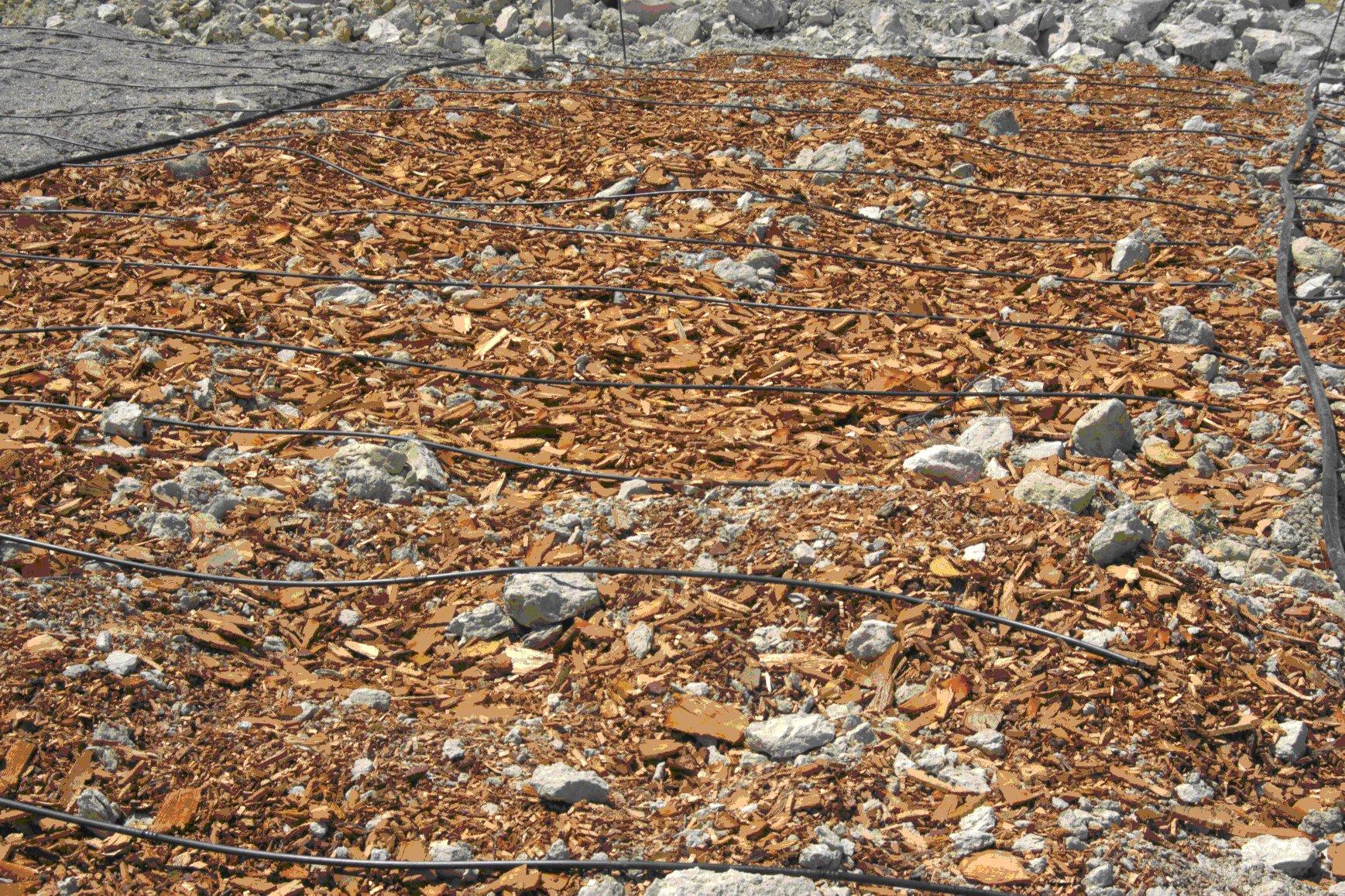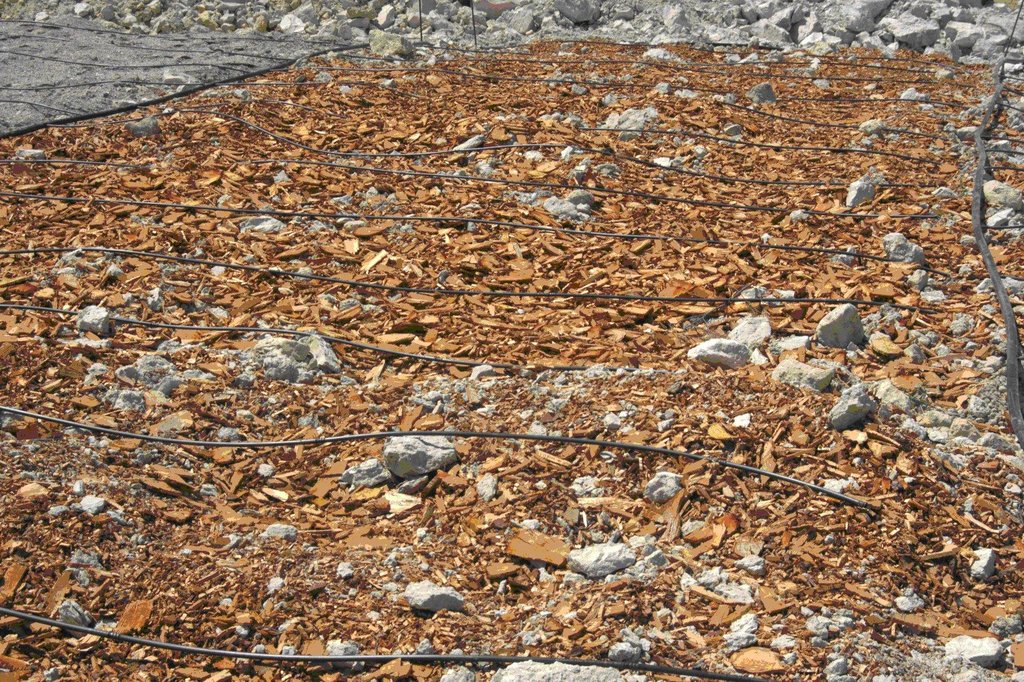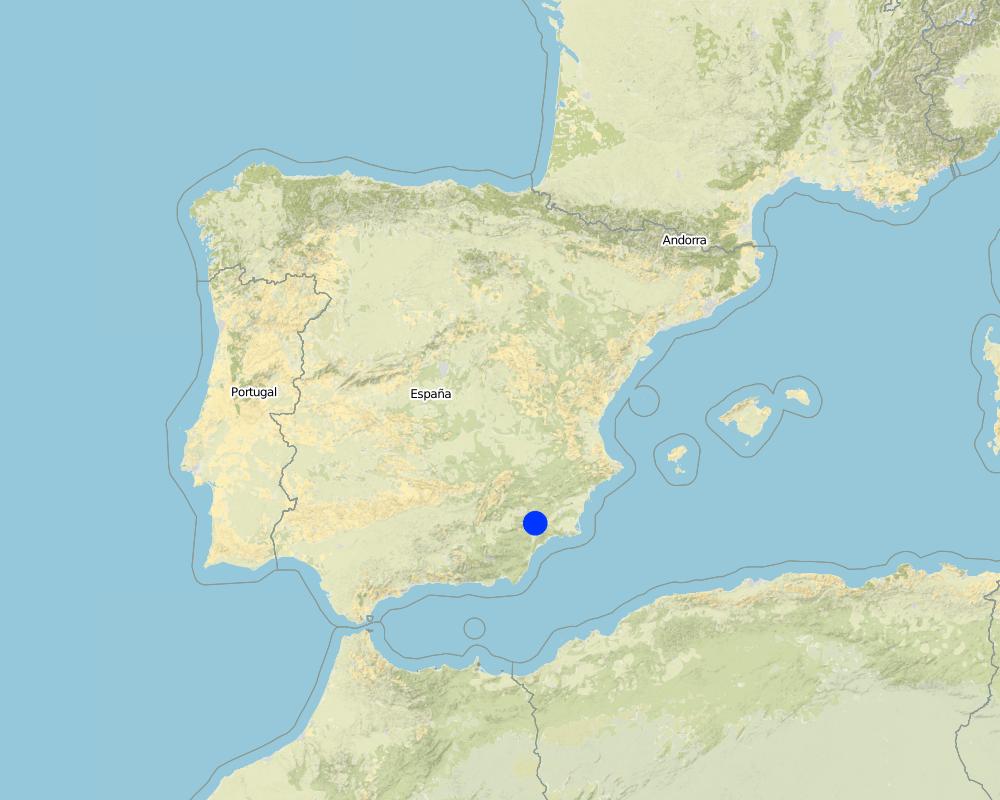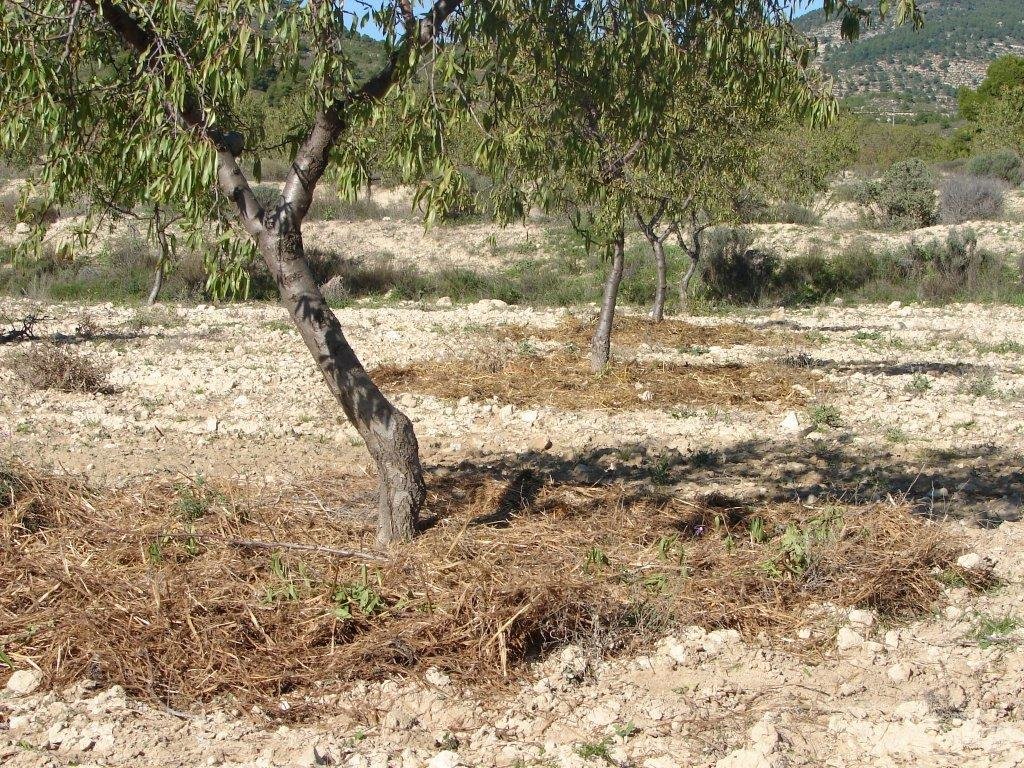Organic mulch under almond trees [إسبانيا]
- تاريخ الإنشاء:
- تحديث:
- جامع المعلومات: Joris De Vente
- المحرر: –
- المراجعون: Alexandra Gavilano, Fabian Ottiger
Acolchados orgánicos en campos de almendro (ES)
technologies_1109 - إسبانيا
عرض الأقسام
توسيع الكل طي الكل1. معلومات عامة
1.2 تفاصيل الاتصال بالأشخاص الرئيسيين لمصدر المعلومات والمؤسسات المشاركة في تقييم وتوثيق التقنية
الشخص (الأشخاص) الرئيسي لمصدر المعلومات
متخصص في الإدارة المستدامة للأراضي:
Ibáñez Torres Ascensión
34.968 36 66 87 / +34 699 65 36 16
ascension.ibanez@carm.es
Responsible technician of the rural development service (CARM). Consejería de Agricultura y Agua Murcia;
اسم المؤسسة (المؤسسات) التي سهلت توثيق/تقييم التقنية (إذا كان ذلك على صلة)
EEZA-CSIC (EEZA-CSIC) - إسبانيا1.3 الشروط المتعلقة باستخدام البيانات الموثقة من خلال WOCAT
متى تم تجميع البيانات (ميدانيا)؟:
05/05/2011
يوافق جامع المعلومات والشخص (لاشخاص) الرئيسي لمصدر المعلومات على الشروط المتعلقة باستخدام البيانات الموثقة من خلال WOCAT:
نعم
1.5 الإشارة إلى الاستبيان (الاستبيانات) حول مناهج الإدارة المستدامة للأراضي
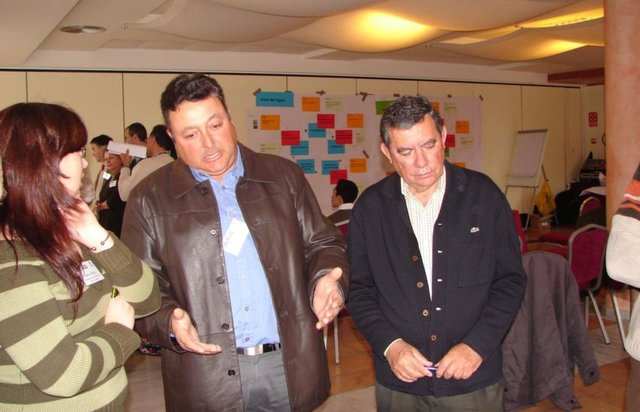
Regional rural development programme [إسبانيا]
Regional development programme to protect natural resources and stimulate rural economies.
- جامع المعلومات: Joris De Vente
2. وصف تقنيةالإدارة المستدامي للأراضي
2.1 وصف مختصر للتقنية
تعريف التقنية:
Organic mulching to protect against rain-splash, sheet wash and rill formation, reduce evaporation losses and weed growth.
2.2 وصف تفصيلي للتقنية
الوصف:
Organic mulch is applied in Almond fields to provide a permanent surface cover that protects the soil against soil erosion, reduces evaporation and limits the growth of weeds. This makes that less ploughing is needed under Almond trees that are normally ploughed 3-5 times per year if no mulch cover is present. The material used for mulching can be diverse. Most feasible are straw or bark and wood chips from pruning residues from almonds and forest species (mostly pines). Alternatively, alpha-grass can be used as mulch. Mulch can best be applied late spring or early summer in order to maintain soil humidity of spring rainfall. Mulch should come mixed and homogenised. It is spread around trees by a mechanical spade or by the arm of a caterpillar. A layer of maximum 3-5 cm of mulch should be applied for economical reasons.
Purpose of the Technology: The ultimate goal of organic mulching under almond trees is to maintain soil water through a reduced evaporation and reduce soil loss by erosion. A mulch covers reduces soil erosion by 1) reducing raindrop impact, 2) increasing water infiltration, 3) increasing surface storage, 4) decreasing runoff velocity, 5) improving soil structure and porosity, and 6) improving the biological activity in the soil. Mulching prevents off-site effects of erosion like flooding, damage to infrastructure and siltation of water reservoirs, while maintaining or slightly increasing crop productivity. The mulch results in a higher soil roughness, a better infiltration of water into the soil, and so also in a reduced runoff. The mulch also has a favorable effect on soil quality since the organic material of the mulch will slowly decompose and provide nutrients to the soil. The decomposing part of the organic mulch will increase aggregation and soil structure through the production of organic compounds (e.g. humic acids). The reduced necessity for ploughing of the Almond fields will result in less fuel use and labour as well as reduced emission of CO2. In addition, the mulch cover prevents weeds to grow and so less competition from weeds will occur and less herbicides are needed.
Establishment / maintenance activities and inputs: The establishment of mulching depends on the material used for mulching. Given its availability, the easiest is the use of pruning residue from Almond trees. Almonds are pruned in autumn, and residue can be chopped and applied directly or stored in the field until early spring. Residues are chopped and spread around the tree stem and if enough material is available between tree stems. Alternatively, and depending on availability, pruning residue of pine trees or alpha-grass can be used. Pine tree residue should come from nearby forest stands and need to be chopped just like the almond pruning residue in spring. Litter from the forest floor should not be used as this will cause damage to the forest. Alpha-grass is very common in the region and should be harvested in winter in the fields surrounding the cultivated area without destroying the plant allowing it to regenerate. The alpha-grass does not need to be chopped and can be put around the tree stem of the almond trees.
Natural / human environment: The technology is feasible for soils of shallow to medium depth (between 20-60 cm), and with gentle to moderate slope gradients (2 - 8%). The climate is semi-arid with a mean annual rainfall around 300 mm. Droughts, centred in summer commonly last for more than 4-5 months. Annual potential evapotranspiration rates larger than 1000 mm are common. The production system is highly mechanised and market oriented but depends strongly on agricultural subsidies. All cropland is privately owned.
2.3 صور التقنية
2.5 البلد/المنطقة/المواقع التي تم تنفيذ التقنية فيها والتي يغطيها هذا التقييم
البلد:
إسبانيا
المنطقة/الولاية/المحافظة:
Murcia
مزيد من التفاصيل حول الموقع:
Guadalentin catchment
Map
×2.6 تاريخ التنفيذ
في حالة عدم معرفة السنة بالتحديد، يرجى الإشارة إلى التاريخ التقريبي:
- منذ 10-50 سنة
2.7 إدخال التقنية
حدد كيف تم إدخال التقنية:
- أثناء التجارب/الأبحاث
التعليقات (نوع المشروع، الخ):
Mulching is a well-known technique. However, until now not widely applied under semi-arid conditions without irrigation. With irrigation, plastic mulch is widely applied.
3. تصنيف تقنية الإدارة المستدامي للأراضي
3.2 نوع (أنواع) استخدام الأراضي الحالية حيث يتم تطبيق التقنية

مختلطة (محاصيل/ رعي/ أشجار)، بما في ذلك الحراجة الزراعية
التعليقات:
Major land use problems (compiler’s opinion): A lack of water availability seriously limits the production potential of the soil and results in a low vegetation/crop cover. The relatively high soil erosion rates cause various off-site related problems (i.e. flooding, reservoir siltation) and on-site problems (i.e. gully formation and loss of soil depth).
Major land use problems (land users’ perception): Lack of water for irrigation of crops limiting the crop types that can be planted as well as the crop yield of dryland farming.
Livestock is grazing on crop residues
3.3 مزيد من المعلومات حول استخدام الأراضي
أخرى (مثل ما بعد الفيضانات):
- all three
التعليقات:
Water supply: rainfed, mixed rainfed - irrigated
عدد مواسم الزراعة في السنة:
- 1
حدد:
Longest growing period in days: 220Longest growing period from month to month: November to June
3.5 انتشار التقنية
حدد انتشار التقنية:
- منتشرة بالتساوي على مساحة
إذا كانت التقنية منتشرة بالتساوي على منطقة ما، فحدد المنطقة التقريبية المغطاة:
- < 0.1 كم2 (10 هكتار)
التعليقات:
No examples are known of organic mulching that are applied in the area.
3.6 التدابير التقنية في مجال إلادارة المستدامة للأراضي

التدابير الزراعية
- A1: الغطاء النباتي/التربة
التعليقات:
Main measures: agronomic measures
Type of agronomic measures: mulching
3.7 الأنواع الرئيسية من تدهور الأراضي التي تناولتها التقنية

تآكل التربة بالمياه
- الوزن(Wt): فقدان التربة السطحية/تآكل السطح
- (Wo:) تأثيرات التدهور من مواقع أخرى

التدهور المادي أو الفيزيائي للتربة
- (Pk)ظهور وتكون قشرة سطحية

تدهور المياه
- (Ha): التجفيف
التعليقات:
Main type of degradation addressed: Wt: loss of topsoil / surface erosion, Pk: sealing and crusting, Ha: aridification
Secondary types of degradation addressed: Wo: offsite degradation effects
Main causes of degradation: crop management (annual, perennial, tree/shrub) (Almond fields often have a very low surface cover by vegetation during long periods of the year, due to frequent ploughing, leaving the soil unprotected against raindrop impact and rill or gully forma), disturbance of water cycle (infiltration / runoff) (Reduced infiltration capacity causing runoff and soil erosion), poverty / wealth (Alternative and more profitable labour sources are a permanent risk of land abandonment that can lead to degradation.)
Secondary causes of degradation: Heavy / extreme rainfall (intensity/amounts) (High intensity erosive rainfall is common), droughts (Dry periods and dry years require higher water availability)
3.8 منع أو حد أو عكس تدهور الأراضي
تحديد هدف التقنية فيما يتعلق بتدهور الأراضي:
- منع تدهور الأراضي
- الحد من تدهور الأراضي
التعليقات:
Main goals: prevention of land degradation, mitigation / reduction of land degradation
4. المواصفات الفنية، وأنشطة التنفيذ، والمدخلات، والتكاليف
4.1 الرسم الفني للتقنية
4.2 المواصفات الفنية/شروحات الرسم الفني
Photo of how the mulch should be divided under the tree stems. If enough material is available, a continuous cover without bare surfaces between trees is recommended.
Technical knowledge required for field staff / advisors: moderate (Knowledge on the type of material used for mulch is essential)
Technical knowledge required for land users: low (The application in the field is simple)
Main technical functions: control of raindrop splash, control of dispersed runoff: retain / trap, control of dispersed runoff: impede / retard, control of concentrated runoff: retain / trap, control of concentrated runoff: impede / retard, improvement of ground cover, increase / maintain water stored in soil
Secondary technical functions: increase of surface roughness, improvement of surface structure (crusting, sealing), increase in organic matter
Mulching
Material/ species: organic material (almond pruning, pine chips, alpha-grass)
Quantity/ density: max 3-5 cm
4.4 أنشطة التأسيس
| النشاط | نوع التدبير | التوقيت | |
|---|---|---|---|
| 1. | Purchase of per (to cut pruning residue) | زراعية |
4.5 التكاليف والمدخلات اللازمة للتأسيس
| تحديد المدخلات | الوحدة | الكمية | التكاليف لكل وحدة | إجمالي التكاليف لكل مدخل | % من التكاليف التي يتحملها مستخدمو الأراضي | |
|---|---|---|---|---|---|---|
| معدات | Per (to cut pruning residue) | piece | 1,0 | 4761,0 | 4761,0 | 100,0 |
| إجمالي تكاليف إنشاء التقنية | 4761,0 | |||||
التعليقات:
Duration of establishment phase: 12 month(s)
Life span of the per: 10 years. Number of parties sharing: 2
4.6 الصيانة/الأنشطة المتكررة
| النشاط | نوع التدبير | التوقيت/الوتيرة | |
|---|---|---|---|
| 1. | Cut alpha-grass (optional) | زراعية | winter |
| 2. | apply mulch of alpha-grass, almond and pine tree pruning residue | زراعية | early spring or autumn after almond pruning |
4.7 التكاليف والمدخلات اللازمة للصيانة/للأنشطة المتكررة (سنويًا)
| تحديد المدخلات | الوحدة | الكمية | التكاليف لكل وحدة | إجمالي التكاليف لكل مدخل | % من التكاليف التي يتحملها مستخدمو الأراضي | |
|---|---|---|---|---|---|---|
| العمالة | Cut alpha-grass (optional) | person/days | 4,0 | 95,25 | 381,0 | 100,0 |
| العمالة | apply mulch of alpha-grass, almond and pine tree pruning residue | person/days | 4,0 | 10,0 | 40,0 | 100,0 |
| معدات | Machine use | person/days | 0,5 | 88,0 | 44,0 | 100,0 |
| الأسمدة والمبيدات الحيوية | Mulch | tons/ha | 15,0 | 55,53333 | 833,0 | 100,0 |
| إجمالي تكاليف صيانة التقنية | 1298,0 | |||||
التعليقات:
Machinery/ tools: Tractor and chopper to chop the almond pruning residue.
The original price of the chopper is estimated at $4761. In calculations it is assumed that the chopper is shared between at least two farmers, and with an average farm size of 10 ha, which gives a price of $238/ha establishment costs. Calculations include the cutting of alpha-grass to apply this as mulch in addition to the chopped almond and pine tree residue. Excluding the alpha-grass as a mulch reduces the total maintenance cost to 650. Leaving out also the chopped pine tree residue and using only the chopped almond pruning residue reduces maintenance costs to $44. The costs were indicated assuming a distance of 7 meter between almond trees and a mulch cover around each tree of 3*3 meters. Prices are for spring 2008.
4.8 أهم العوامل المؤثرة على التكاليف
قدم وصفا لأهم العوامل التي تؤثر على التكاليف:
Labour for cutting alpha grass, and the price of the mulch are most determining factors of the costs. Almond prunings are free of charge (except for costs to chop them), but will not provide enough mulch. Chopped Pine pruning or straw mulch are relatively expensive.
5. البيئة الطبيعية والبشرية
5.1 المناخ
هطول الأمطار السنوي
- < 250 مم
- 251- 500 ملم
- 501 - 750ملم
- 1,000-751 ملم
- 1,500-1,100 ملم
- 2,000-1,500 ملم
- 3,000-2,001 ملم
- 4,000-3,100 ملم
- > 4000 ملم
المنطقة المناخية الزراعية
- شبه قاحلة
Thermal climate class: subtropics
Thermal climate class: temperate. The higher parts are generally somewhat colder
5.2 طوبوغرافيا
متوسط الانحدارات:
- مسطح (0-2%)
- بسيط (3-5%)
- معتدل (6-10%)
- متدحرج (11-15%)
- تلال (16-30%)
- شديدة الانحدار(31-60%)
- فائقة الانحدار (>60%)
التضاريس:
- هضاب/سهول
- أثلام مرتفعة
- المنحدرات الجبلية
- منحدرات التلال
- منحدرات في السفوح
- قاع الوادي
المنطقة الارتفاعية:
- 100-0 متر فوق سطح البحر
- 500-101 متر فوق سطح البحر
- 1,000-501 متر فوق سطح البحر
- 1,500-1,001 متر فوق سطح البحر
- 2,000-1,501 متر فوق سطح البحر
- 2,500-2,100 متر فوق سطح البحر
- 3,000-2,501 متر فوق سطح البحر
- 4,000-3,001 متر فوق سطح البحر
- > 4000 متر فوق سطح البحر
5.3 التربة
متوسط عمق التربة:
- ضحل جدًا (0-20 سم)
- ضحلة (21-50 سم)
- متوسطة العمق (51-80 سم)
- عميقة (81-120 سم)
- عميقة جدًا (> 120 سم)
قوام التربة (التربة السطحية):
- متوسط ( طميي، سلتي)
- ناعم/ثقيل (طيني)
المواد العضوية في التربة السطحية:
- متوسطة (1-3%)
- منخفضة (<1%)
5.4 توافر المياه ونوعيتها
منسوب المياه الجوفية:
50-5 م
توافر المياه السطحية:
ضعيف/ غير متوافر
نوعية المياه (غير المعالجة):
للاستخدام الزراعي فقط (الري)
5.5 التنوع البيولوجي
تنوع الأنواع:
- منخفض
5.6 خصائص مستخدمي الأراضي الذين يطبقون التقنية
التوجه السوقي لنظام الإنتاج:
- مختلط (كفاف/ تجاري)
- تجاري/سوق
الدخل من خارج المزرعة:
- >50% من إجمالي الدخل
المستوى النسبي للثروة:
- متوسط
أفراداً أو مجموعات:
- فرد/أسرة معيشية
مستوى المكننة:
- ميكانيكية/ مزودة بمحرك
الجنس:
- رجال
اذكر الخصائص الأخرى ذات الصلة لمستخدمي الأراضي:
Land users applying the Technology are mainly common / average land users
Difference in the involvement of women and men: Traditionally most agriculture is done by men in this region.
Population density: 10-50 persons/km2
Annual population growth: < 0.5%
15% of the land users are rich and own 20% of the land.
80% of the land users are average wealthy and own 75% of the land.
5% of the land users are poor and own 5% of the land.
Off-farm income specification: There is no difference in the ones who apply the technology and those who don’t. Most farmers do have an off-farm income for example from hunting, work in a factory, or office.
5.7 متوسط مساحة الأرض المملوكة أو المستأجرة من قبل مستخدمي الأراضي الذين يطبقون التقنية
- < 0.5 هكتارا
- 0.5 - 1 هكتار
- 1 -2 هكتار
- 2 - 5 هكتار
- 5 - 15 هكتار
- 15 - 50 هكتار
- 50 - 100هكتار
- 500-100 هكتار
- 1,000-500 هكتار
- 10,000-1,000 هكتار
- > 10,000 هكتار
هل يعتبر هذا نطاقًا صغيرًا أو متوسطًا أو واسعا (في إشارة إلى السياق المحلي)؟:
- على نطاق صغير
التعليقات:
Average area of land owned or leased by land users applying the Technology: 15-50 ha, 50-100 ha, 100-500 ha
5.8 ملكية الأراضي، وحقوق استخدام الأراضي، وحقوق استخدام المياه
ملكية الارض:
- دولة
- فردية، يوجد سند ملكية
حقوق استخدام الأراضي:
- مجتمعي (منظم)
- فردي
حقوق استخدام المياه:
- مجتمعي (منظم)
- فردي
التعليقات:
Most land is privately owned. Some shrubland or forest is state property. Water use is organised by permits to water extraction from aquifers on individual basis. Water rights are provided and controlled by the Water authority of the Segura river basin (CHS).
5.9 الوصول إلى الخدمات والبنية التحتية
الصحة:
- ضعيف
- معتدل
- جيد
التعليم:
- ضعيف
- معتدل
- جيد
المساعدة التقنية:
- ضعيف
- معتدل
- جيد
العمل (على سبيل المثال خارج المزرعة):
- ضعيف
- معتدل
- جيد
الأسواق:
- ضعيف
- معتدل
- جيد
الطاقة:
- ضعيف
- معتدل
- جيد
الطرق والنقل:
- ضعيف
- معتدل
- جيد
مياه الشرب وخدمات الصرف الصحي:
- ضعيف
- معتدل
- جيد
الخدمات المالية:
- ضعيف
- معتدل
- جيد
6. الآثار والتصريحات الختامية
6.1 الآثار التي أظهرتها التقنية في الموقع
الآثار الاجتماعية والاقتصادية
الإنتاج
إنتاج المحاصيل
توافر المياه ونوعيتها
الطلب على مياه الري
الدخل والتكاليف
النفقات على المدخلات الزراعية
دخل المزرعة
الآثار الاجتماعية والثقافية
المعرفة بالإدارة المستدامة للأراضي/تدهور الأراضي
التخفيف من حدة الصراع
الآثار الايكولوجية
دورة المياه / الجريان السطحي
جودة المياه
الجريان السطحي
تصريف المياه الزائدة
التبخر
التربة
رطوبة التربة
غطاء التربة
فقدان التربة
تكون قشرة التربة السطحية/انسداد مسام التربة
المادة العضوية في التربة/تحت الطبقة c
التنوع البيولوجي: الغطاء النباتي، الحيوانات
التنوع الحيواني
الأنواع المفيدة
الحد من مخاطر المناخ والكوارث
انبعاث الكربون والغازات المسببة للاحتباس الحراري
6.2 الآثار التي أظهرتها التقنية خارج الموقع
الفيضان في اتجاه مجرى النهر
تراكم الطمي باتجاه مصب النهر
تلوث المياه الجوفية/الأنهار
القدرة على التخفيف / الترشيح
الرواسب المنقولة بواسطة الرياح
الأضرار التي لحقت بحقول الجيران
الضرر على البنية التحتية العامة/ الخاصة
6.3 تعرض التقنية وحساسيتها لتغير المناخ التدريجي والظواهر المتطرفة/الكوارث المرتبطة بالمناخ (كما يراها مستخدمو الأراضي)
تغير مناخ تدريجي
تغير مناخ تدريجي
| الموسم | نوع التغير المناخي/ المتطرف | كيف تتعامل التقنية مع ذلك؟ | |
|---|---|---|---|
| درجة الحرارة السنوية | زيادة | جيدا |
الظواهر المتطرفة / الكوارث المرتبطة بالمناخ
الكوارث الجوية
| كيف تتعامل التقنية مع ذلك؟ | |
|---|---|
| عاصفة ممطرة محلية | جيدا |
| عاصفة هوائية محلية | جيدا |
الكوارث المناخية
| كيف تتعامل التقنية مع ذلك؟ | |
|---|---|
| جفاف | جيدا |
الكوارث الهيدرولوجية
| كيف تتعامل التقنية مع ذلك؟ | |
|---|---|
| فيضان عام (نهر) | ليس جيدا |
العواقب الأخرى المتعلقة بالمناخ
العواقب الأخرى المتعلقة بالمناخ
| كيف تتعامل التقنية مع ذلك؟ | |
|---|---|
| انخفاض فترة النمو | جيدا |
6.4 تحليل التكلفة والعائد
كيف يمكن مقارنة العوائد نسبة لتكاليف الإنشاء (من وجهة نظر مستخدمي الأراضي)؟
عوائد قصيرة الأجل:
سلبي
عوائد طويلة الأجل:
إيجابي قليلا
كيف تتم مقارنة العوائدمع كلفة الصيانة/التكاليف المتكررة (من وجهة نظر مستخدمي الأراضي)؟
عوائد قصيرة الأجل:
سلبي قليلا
عوائد طويلة الأجل:
إيجابي قليلا
التعليقات:
Mulch is relatively expensive and so implies an additional cost.
6.5 اعتماد التقنية
التعليقات:
There is no trend towards spontaneous adoption of the Technology
Comments on adoption trend: There is not so much awareness, and most farmers are afraid of possible costs of mulching and don’t count on increased crop yield.
6.7 نقاط القوة / المزايا / الفرص التي توفرها التقنية
| نقاط القوة/ المزايا/ الفرص من وجهة نظر مستخدمي الأراضي |
|---|
|
A good surface cover throughout the year provides good protection against erosion and helps reducing number of tillage operations and expenses How can they be sustained / enhanced? no suggestions |
| نقاط القوة/ المزايا/ الفرص من وجهة نظر جامع المعلومات أو غيره من الاشخاص الرئيسيين لمصدر المعلومات |
|---|
|
The main advantage is that a good surface cover is obtained below almonds that traditionally are characterised by a very poor surface cover during the whole year. The mulch will reduce evaporation and prevent erosion to take place. How can they be sustained / enhanced? Cheapest type of mulch should be identified (alpha grass, chopped pruning residues, …). |
6.8 نقاط ضعف / مساوىء / مخاطر التقنية وسبل التغلب عليها
| نقاط الضعف/ المساوىء/ المخاطر من وجهة نظر مستخدم الأراضي | كيف يمكن التغلب عليها؟ |
|---|---|
| The price of the mulch | Look for alternative low cost materials |
| نقاط الضعف/ المساوىء/ المخاطر من وجهة نظر جامع المعلومات أو غيره من الاشخاص الرئيسيين لمصدر المعلومات | كيف يمكن التغلب عليها؟ |
|---|---|
| The price of the mulch and/or the price of carrying it to the field | Look for alternative low cost materials, the nearest to the plots as possible. |
| Once the mulch in situ, any tillage operation would incorporate it to the soil, reducing part of its initial benefit; if the mulch is green (alpha grass) it would depress soil N levels upon decomposition, though it would increase SOM in the medium-long term | Avoid tillage in mulched areas |
7. المراجع والروابط
7.2 المراجع للمنشورات المتاحة
العنوان، المؤلف، السنة، النظام القياسي الدولي لترقيم الكتب ISBN:
Smets, T., Poesen, J. and Knapen, A., 2008. Spatial scale effects on the effectiveness of organic mulches in reducing soil erosion by water. Earth-Science Reviews, 89(1-2): 1-12.
متاح من أين؟كم التكلفة؟:
Internet
العنوان، المؤلف، السنة، النظام القياسي الدولي لترقيم الكتب ISBN:
Verdu and Mas 2007. Mulching as an alternative technique for weed management in mandarin orchard tree rows. AGRONOMY FOR SUSTAINABLE DEVELOPMENT. 27(4): 367-375
متاح من أين؟كم التكلفة؟:
Internet
العنوان، المؤلف، السنة، النظام القياسي الدولي لترقيم الكتب ISBN:
http://www.isahispana.com/
متاح من أين؟كم التكلفة؟:
Internet
العنوان، المؤلف، السنة، النظام القياسي الدولي لترقيم الكتب ISBN:
Mellouli, H.J., van Wesemael, B., Poesen, J. and Hartmann, R., 2000. Evaporation losses from bare soils as influenced by cultivation techniques in semi-arid regions. Agricultural Water Management, 42(3): 355-369.
متاح من أين؟كم التكلفة؟:
Internet
الروابط والوحدات المواضيعية
توسيع الكل طي الكلالروابط

Regional rural development programme [إسبانيا]
Regional development programme to protect natural resources and stimulate rural economies.
- جامع المعلومات: Joris De Vente
الوحدات المواضيعية
لا يوجد وحدات مواضيعية


